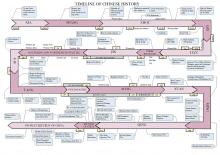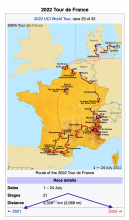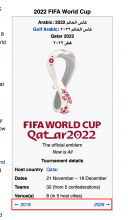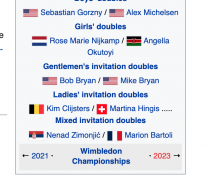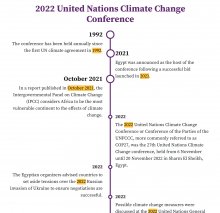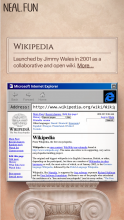This task involves the work with of introducing a dedicated workflow to help people create timelines (read: display a list of events in chronological order).
Stories
- As someone who arrived at Wikipedia seeking to develop a general understanding of a person's life, a conflict, a scientific discovery, a nation, a culture, a sociological phenomenon, etc., I would like to able to search for and see the significant events related to said topic, so that I can quickly learn how this person/war/idea/movement/etc. developed, became historically significant, and perhaps, relevant to "me."
- As someone who who is motivated to improve Wikipedia, I would like to be able to easily order and display the notable events within a given page, so that people who come after me will have an easier time understanding the subject at-hand.
- As someone who finds images/sounds/videos help them learn more effectively, I would like to be able to add/relate a file from Commons to a particular event, so that I can more deeply understand the topic/person/idea/event at-hand.
Background
Many Wikipedia articles include events mapped to points in time. [i] Some Wikipedia articles are entirely dedicated to mapping events to points in time. [ii]
Relating events to time in a visual way seems to be valuable enough to readers that volunteers have created many custom ways of presenting time-based information. [iii][vii]
And while some volunteers have discovered these templates and used them to visually relate time and events [iv], many articles A) lack any kind of visual relating time and events [v] or B) have done so in ways that could be improved to help people search for, understand, engage with, and use as a vector for discovery [vi]
Open questions
- 1. What percentage of articles, across projects contain dates and events (read: information that would make sense to display in a timeline-like experience)?
- 2. Would current – and prospective – readers find a timeline-like experience to be an intuitive and helpful way to learn, retrieve information, etc?
- What specific questions/curiosities might a timeline-like format help people coming to Wikipedia to learn to help answer?
Hypotheses/Possibilities/Assumptions
- Framing editing/contributing to Wikipedia as adding/documenting an "event" will cause people who might never have considered editing to a) clearly see/understand what doing so would be like and b) see opportunities to contribute to Wikipedia that they wouldn't have noticed otherwise
- Enabling people to explore Wikipedia through time will cause them to explore pages and learn things they wouldn't have had they been navigating via topics
Related
- Concepts/Explorer
- Routemap templates (demo | project page): an example of a powerful timeline-like template that's used on ~15,200 en.wiki article pages: Template:BS-map in use on ~2,200 article pages + Template:Routemap in use on ~13,000 article pages.
- Histropedia: a Wikidata- and Wikipedia-powered timeline project that contains ~300,000 timelines. //E.g. Pixar animated films, Universities throughout the world, Scientists
References
- A collection of hundreds of examples for how different cultures have visualize time throughout history
- History-of-Paris#Saint-Genevieve via @nayoub via @cmadeo
- "...more pictures and visual data to be included so (...) content can be remembered (..)” | via Wikipedia Android App Onboarding Survey
- The write up @ihurbain put together for their Inspiration Week timeline project:Engineering/Inspiration Week 2022/Projects/Timeline Generator
- On desktop, the infoboxes within articles about the yearly occurrences of recurring events – like the 2022 Tour de France, 2022 Wimbledon Championships), and the 2022 World Cup – offer people the ability to "move" forward and backward through time to previous years' occurrences:
- Classtools.net/timeline: convert any Wikipedia Page into an editable Timeline. via @ihurbain .
- Research:Wikistories Africa Research
- #TODO: look into finding @Arrbee shared about new/younger contributors seeking the satisfaction/pride/etc. they experience through creating something whole/discrete/new on services like Instagram, YouTube, Twitter, TikTok, etc.
- Research:Wikistories Indonesia Concept Testing
- Al Jazeera Start Here: "What's happening in Sri Lanka:
- Android Timeline-styled ToC:
- TimelineJS via @nayoub.
- Histography.io. via @nayoub.
- WinkNLP Wikipedia Timeline Generator. via @nayoub + @Prtksxna
i. Search of pages in the main namespace that include the word "Timeline": en.wiki (130,000 articles dedicated to timelines), es.wiki (2,100 articles dedicated to "línea de tiempo")
ii. en:Timeline of the Barack Obama presidency (2009), en:Timeline of the Egyptian revolution of 2011, Timeline of the COVID-19 pandemic in Nigeria (February–June 2020). See also: Special:Categories "Timelines", 1975 (the year)
iii. Extension:EasyTimeline, Category:Graphical timeline templates, Category:Timeline templates
iv. bn:History of computing, ja:Extinction events, en:Imam
v. ru:Historical varieties of window openings, en:The history of thermal insulation, en:Architecture of India, en:Plywood history, es: History of peanut butter
vi. en:Invention of radio, en:Gaius Marius, af: Voyager 2 travel timeline
vii. en:List of timelines
